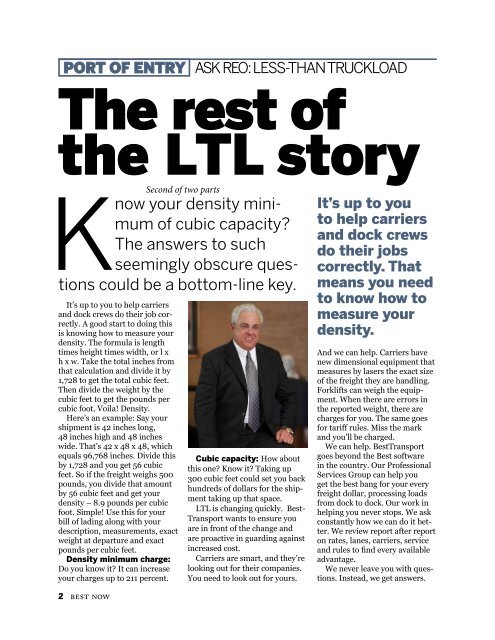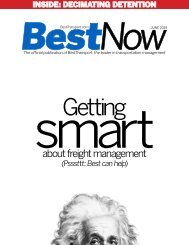BestENews1218
You also want an ePaper? Increase the reach of your titles
YUMPU automatically turns print PDFs into web optimized ePapers that Google loves.
PORT OF ENTRY ASK REO: LESS-THAN TRUCKLOAD<br />
The rest of<br />
the LTL story<br />
It’s up to you to help carriers<br />
and dock crews do their job correctly.<br />
A good start to doing this<br />
is knowing how to measure your<br />
density. The formula is length<br />
times height times width, or l x<br />
h x w. Take the total inches from<br />
that calculation and divide it by<br />
1,728 to get the total cubic feet.<br />
Then divide the weight by the<br />
cubic feet to get the pounds per<br />
cubic foot. Voila! Density.<br />
Here’s an example: Say your<br />
shipment is 42 inches long,<br />
48 inches high and 48 inches<br />
wide. That’s 42 x 48 x 48, which<br />
equals 96,768 inches. Divide this<br />
by 1,728 and you get 56 cubic<br />
feet. So if the freight weighs 500<br />
pounds, you divide that amount<br />
by 56 cubic feet and get your<br />
density – 8.9 pounds per cubic<br />
foot. Simple! Use this for your<br />
bill of lading along with your<br />
description, measurements, exact<br />
weight at departure and exact<br />
pounds per cubic feet.<br />
Density minimum charge:<br />
Do you know it? It can increase<br />
your charges up to 211 percent.<br />
Second of two parts<br />
Know your density minimum<br />
of cubic capacity?<br />
The answers to such<br />
seemingly obscure questions<br />
could be a bottom-line key.<br />
Cubic capacity: How about<br />
this one? Know it? Taking up<br />
300 cubic feet could set you back<br />
hundreds of dollars for the shipment<br />
taking up that space.<br />
LTL is changing quickly. Best-<br />
Transport wants to ensure you<br />
are in front of the change and<br />
are proactive in guarding against<br />
increased cost.<br />
Carriers are smart, and they’re<br />
looking out for their companies.<br />
You need to look out for yours.<br />
It’s up to you<br />
to help carriers<br />
and dock crews<br />
do their jobs<br />
correctly. That<br />
means you need<br />
to know how to<br />
measure your<br />
density.<br />
And we can help. Carriers have<br />
new dimensional equipment that<br />
measures by lasers the exact size<br />
of the freight they are handling.<br />
Forklifts can weigh the equipment.<br />
When there are errors in<br />
the reported weight, there are<br />
charges for you. The same goes<br />
for tariff rules. Miss the mark<br />
and you’ll be charged.<br />
We can help. BestTransport<br />
goes beyond the Best software<br />
in the country. Our Professional<br />
Services Group can help you<br />
get the best bang for your every<br />
freight dollar, processing loads<br />
from dock to dock. Our work in<br />
helping you never stops. We ask<br />
constantly how we can do it better.<br />
We review report after report<br />
on rates, lanes, carriers, service<br />
and rules to find every available<br />
advantage.<br />
We never leave you with questions.<br />
Instead, we get answers.<br />
2 best now













